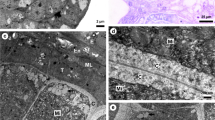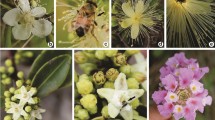Abstract
The mango (Mangifera indica) is a woody perennial crop currently cultivated worldwide in regions with tropical and subtropical climates. Despite its importance, an essential process such as pollen development, and, specifically, cell wall composition that influences crosstalk between somatic cells and the male germline, is still poorly understood in this species and in the Anacardiaceae as a whole. A detailed understanding of this process is particularly important to know the effect of low temperatures during flowering on pollen development that can be a limiting factor for fertilization and fruit set. To fill this gap, we performed a thorough study on the cell wall composition during pollen development in mango. The results obtained reveal a clear differentiation of the cell wall composition of the male germline by pectins, AGPs and extensins from the early developmental stages during microsporogenesis and microgametogenesis reflecting a restricted communication between the male germline and the surrounding somatic cells that is very sensitive to low temperatures. The combination of the results obtained provides an integrated study on cell wall composition of the male germline in mango that reveals the crucial role of the sporophyte and the gametophyte and the vulnerability of the process to low temperatures.






Similar content being viewed by others
References
Belhadj S, Derridj A, Civeyrel L, Gers C, Aigouy T, Otto T (2007) Pollen morphology and fertility of wild Atlas pistachio (Pistacia atlantica Desf., Anacardiaceae). Grana 46:148–156
Blackmore S, Crane PR (1998) The evolution of apertures in the spores and pollen grains of Embryophytes. In: Owens JS, Rudall PJ (eds) Reproductive biology. Royal Botanic Gardens, Kew, pp 159–182
Blackmore S, Wortley AH, Skvarla JJ, Rowley JR (2007) Pollen wall development in flowering plants. New Phytol 174:483–498
Bompard JM (2009) Taxonomy and systematics. In: Litz RE (ed) The mango: botany, production and uses. CABI, Wallingford, pp 19–41
Coetzer LA, Oosthuyse SA, Wishart DL, Robbertse PJ (1995) Influence of pruning on the flower sex ratio in some mango cultivars. S Afr Mango Grow Assoc Yearb 15:26–30
Coimbra S, Almeida J, Junqueira V et al (2007) Arabinogalactan proteins as molecular markers in Arabidopsis thaliana sexual reproduction. J Exp Bot 58:4027–4035
Coimbra S, Costa M, Jones B et al (2009) Pollen grain development is compromised in Arabidopsis agp6 agp11 null mutants. J Exp Bot 60:3133–3142
Copeland H (1959) The reproductive structure of Schinus molle (Anacardiaceae). Madroño 15:14–25
Cosgrove DJ (2005) Growth of the plant cell wall. Nat Rev Mol Cell Biol 6:850–861
Costa M, Pereira AM, Rudall PJ, Coimbra S (2013) Immunolocalization of arabinogalactan proteins (AGPs) in reproductive structures of an early-divergent angiosperm, Trithuria (Hydatellaceae). Ann Bot 111:183–190
Costa ML, Sobral R, Ribeiro Costa MM et al (2015) Evaluation of the presence of arabinogalactan proteins and pectins during Quercus suber male gametogenesis. Ann Bot 115:81–92
D’Arcy WG (1996) Anthers and stamens and what they do. In: D’Arcy WG, Keating RC (eds) The anther: form, function, and phylogeny. Cambridge University Press, Cambridge, pp 1–25
Dag A, Eisenstein D, Gazit S (2000) Effect of temperature regime on pollen and the effective pollination of “Kent” mango in Israel. Sci Hortic 86:1–11
de Oliveira JMS, de Mariath JEA (2001) Anther and pollen development in Anacardium occidentale (Anacardiaceae) clone CP76. Phytomorphology 51:91–100
de Wet E, Robbertse PJ (1986) A preliminary study of the pollen of Mangifera indica L. cv. Haden in South Africa. South African J Plant Soil 3:87–89
de Wet E, Robbertse PJ, Groeneveld HT (1989) The influence of temperature and boron on pollen germination in Mangifera indica L. South African J Plant Soil 6:228–234
Evans EA, Mendoza OJ (2009) World mango trade and the economics of mango production. In: Litz RE (ed) The mango: botany, production and uses. CABI, Wallingford, pp 606–627
FAO (2017) Agricultural data: FAOSTAT. http://www.fao.org/faostat/en/?#data/QC. Accessed 20 Feb 2017
Feder N, O’Brien TP (1968) Plant microtechnique: some principles and new methods. Am J Bot 55:123–142
Furness CA, Rudall PJ (2001) The tapetum in basal angiosperms: early diversity. Int J Plant Sci 162:375–392
Furness CA, Rudall PJ (2004) Pollen aperture evolution—a crucial factor for eudicot success? Trends Plant Sci 9:154–158
Gómez JF, Talle B, Wilson ZA (2015) Anther and pollen development: a conserved developmental pathway. J Integr Plant Biol 57:876–891
Hafidh S, Fíla J, Honys D (2016) Male gametophyte development and function in angiosperms: a general concept. Plant Reprod 29:31–51
Hedhly A (2011) Sensitivity of flowering plant gametophytes to temperature fluctuations. Environ Exp Bot 74:9–16
Hedhly A, Hormaza JI, Herrero M (2009) Global warming and sexual plant reproduction. Trends Plant Sci 14:30–36
Heslop-Harrison J (1968) Pollen wall development. Science (80-) 161:230–237
Heslop-Harrison J (1975a) The adaptive significance of the exine. In: Ferguson JK, Muller J (eds) The evolutionary significance of the exine. Linnean Society of london, London, pp 27–37
Heslop-Harrison J (1975b) Incompatibility and the pollen-stigma interaction. Ann Rev Plant Physiol 26:403–425
Hess M (1993) Cell-wall development in freeze-fixed pollen: intine formation of Ledebouria socialis (Hyacinthaceae). Planta 189:139–149
Hesse M (2000) Pollen wall stratification and pollination. Plant Syst Evol 222:1–17
Huang J-H, Ma W-H, Liang G-L, Zhang L-Y, Wang W-X, Cai Z-J, Wen S-X (2010) Effects of low temperatures on sexual reproduction of “Tainong 1” mango (Mangifera indica). Sci Hortic 126:109–119
Hughes J, McCully ME (1975) Use of an optical brightener in study of plant structure. Stain Technol 50:319–329
Ibe RA, Leis RA (1979) Pollen morphology of the Anacardiaceae of northeastern north America. Bull Torrey Bot Club 106:140–144
Issarakraisila M, Considine J (1994) Effects of temperature on pollen viability in Mango cv. ‘Kensington’. Ann Bot 73:231–240
Jia Q-S, Zhu J, Xu X-F, Lou Y, Zhang Z-L, Yang Z-N (2015) Arabidopsis AT-hook protein TEK positively regulates the expression of arabinogalactan proteins for nexine formation. Mol Plant 8:251–260
Kelkar S (1958) Embryology of rhus mysurensis heyne. J Indian Bot Soc 37:114–122
Knox JP (1997) The use of antibodies to study the architecture and developmental regulation of plant cell walls. Int Rev Cytol 171:79–120
Knox JP, Linstead PJ, Cooper JPC, Roberts K (1991) Developmentally regulated epitopes of cell surface arabinogalactan proteins and their relation to root tissue pattern formation. Plant J 1:317–326
Levitin B, Richter D, Markovich I, Zik M (2008) Arabinogalactan proteins 6 and 11 are required for stamen and pollen function in Arabidopsis. Plant J 56:351–363
Lora J, Testillano PS, Risueno MC et al (2009) Pollen development in Annona cherimola Mill. (Annonaceae). Implications for the evolution of aggregated pollen. BMC Plant Biol 9:129
Lora J, Herrero M, Hormaza JI (2014) Microspore development in Annona (Annonaceae): differences between monad and tetrad pollen. Am J Bot 101:1508–1518
Lora J, Hormaza JI, Herrero M (2016) The diversity of the pollen tube pathway in plants: toward an increasing control by the sporophyte. Front Plant Sci 7:107
Lou Y, Xu X, Zhu J et al (2014) The tapetal AHL family protein TEK determines nexine formation in the pollen wall. Nat Commun 5:3855
Maheshwari P (1934) The Indian Mango. Curr Sci 3:97–98
Majewska-Sawka A, Rodriguez-Garcia MI (2006) Immunodetection of pectin and arabinogalactan protein epitopes during pollen exine formation of Beta vulgaris L. Protoplasma 228:41–47
Mascarenhas JP (1989) The male gametophyte of flowering plants. Plant Cell 1:657–664
Matamoro-Vidal A, Raquin C, Brisset F, Colas H, Izac B, Béatrice A, Gouyon P-H (2016) Links between morphology and function of the pollen wall: an experimental approach. Bot J Linn Soc 180:478–490
McCormick S (1993) Male gametophyte development. Plant Cell 5:1265–1275
McCormick S (2004) Control of male gametophyte development. Plant Cell 16:S142–S153
Mukherjee SK, Litz RE (2009) Introduction: botany and importance. In: Litz RE (ed) The mango: botany, production and uses. CABI, Wallingford, pp 1–18
Nothnagel E, Münster A, Majewska-Sawka A (2001) Arabinogalactan proteins in differentiation of gametes and somatic cells. In: Bohanec B (ed) Biotechnological approaches for utilization of gametic cells. Office for Official Publications of the European Communities, Luxembourg, pp 237–246
Otegui MS, Staehelin LA (2004) Electron tomographic analysis of post-meiotic cytokinesis during pollen development in Arabidopsis thaliana. Planta 218:501–515
Pacini E (2010) Relationships between tapetum, loculus, and pollen during development. Int J Plant Sci 171:1–11
Pacini E, Hesse M (2004) Cytophysiology of pollen presentation and dispersal. Flora 199:273–285
Pacini E, Franchi GG, Hesse M (1985) The tapetum—its form, function, and possible phylogeny in Embryophyta. Plant Syst Evol 149:155–185
Palin R, Geitmann A (2012) The role of pectin in plant morphogenesis. Biosystems 109:397–402
Pell SK, Mitchell JD, Miller AJ, Lobova TA (2010) Anacardiaceae. In: Kubitzki K (ed) Flowering plants. Eudicots. Springer, Heidelberg, pp 7–50
Pennell RI, Janniche L, Kjellbom P et al (1991) Developmental regulation of a plasma membrane arabinogalactan protein epitope in oilseed rape flowers. Plant Cell 3:1317–1326
Pérez V, Herrero M, Hormaza JI (2016) Self-fertility and preferential cross-fertilization in mango (Mangifera indica). Sci Hortic 213:373–378
Periasamy K, Amalathas J (1991) Absence of callose and tetrad in the microsporogenesis of Pandanus odoratissimus with well-formed pollen exine. Ann Bot 67:29–33
Quilichini TD, Grienenberger E, Douglas CJ (2015) The biosynthesis, composition and assembly of the outer pollen wall: a tough case to crack. Phytochemistry 113:170–182
Ramírez F, Davenport TL (2010) Mango (Mangifera indica L.) flowering physiology. Sci Hortic 126:65–72
Ramírez F, Davenport TL (2016) Mango (Mangifera indica L.) pollination: a review. Sci Hortic 203:158–168
Sabatini DD, Bensch K, Barrnett RJ (1963) Cytochemistry and electron microscopy—preservation of cellular ultrastructure and enzymatic activity by aldehyde fixation. J Cell Biol 17:19–58
Satpute GK, Long H, Seguí-Simarro JM et al (2005) Cell architecture during gametophytic and embryogenic microspore development in Brassica napus L. Acta Physiol Plant 27:665–674
Shi J, Cui M, Yang L, Kim YJ, Zhang D (2015) Genetic and biochemical mechanisms of pollen wall development. Trends Plant Sci 20:741–753
Singh U (1960) Studies in the fruit drop of mango (Mangifera indica L.) II. Nature and extent of fruit drop. Hortic Adv 4:142–154
Smallwood M, Beven A, Donovan N, Neill SJ, Peart J, Roberts K (1994) Localization of cell wall proteins in relation to the developmental anatomy of the carrot root apex. Plant J 5:237–246
Solís M-T, Pintos B, Prado M-J et al (2008) Early markers of in vitro microspore reprogramming to embryogenesis in olive (Olea europaea L.). Plant Sci 174:597–605
Srinivasachar D (1940) Morphological studies in the family Anacardiaceae. Half-Yearly J Mysore Univ Sect B Sci 1:83–91
Torres MD, Guirado E, Farré JM, Hermoso JM (2009) Pre-bloom shoot tipping of mango. Influence on yield, fruit size and quality. Acta Hortic 820:391–394. https://doi.org/10.17660/ActaHortic.2009.820.46
Tucker MR, Paech NA, Willemse MTM, Koltunow AMG (2001) Dynamics of callose deposition and beta-1,3-glucanase expression during reproductive events in sexual and apomictic Hieracium. Planta 212:487–498
Viruel MA, Escribano P, Barbieri M, Ferri M, Hormaza JI (2005) Fingerprinting, embryo type and geographic differentiation in mango (Mangifera indica L., Anacardiaceae) with microsatellites. Mol Breed 15:383–393
Wilson ZA, Zhang D-B (2009) From Arabidopsis to rice: pathways in pollen development. J Exp Bot 60:1479–1492
Wunnachit W, Jenner C, Sedgley M (1992) Pollen vigour and composition in relation to andromonoecy in cashew (Anacardium occidentale L.: Anacardiaceae). Sex Plant Reprod 5:264–269
Author contribution statement
JL and JIH conceived and designed the study project. JL performed the experiments. JL and JIH wrote, reviewed and edited this manuscript.
Acknowledgements
This work was supported by Ministerio de Economía y Competitividad—European Regional Development Fund, European Union (AGL2015-74071-JIN, AGL2016-77267-R). Distribution of the JIM antibodies used in this work was supported in part by NSF grants DBI-C421683 and RCN009281.
Author information
Authors and Affiliations
Corresponding author
Ethics declarations
Conflict of interest
The authors declare that they have no conflict of interest.
Additional information
Communicated by Dolf Weijers.
Electronic supplementary material
Below is the link to the electronic supplementary material.
Rights and permissions
About this article
Cite this article
Lora, J., Hormaza, J.I. Pollen wall development in mango (Mangifera indica L., Anacardiaceae). Plant Reprod 31, 385–397 (2018). https://doi.org/10.1007/s00497-018-0342-5
Received:
Accepted:
Published:
Issue Date:
DOI: https://doi.org/10.1007/s00497-018-0342-5




